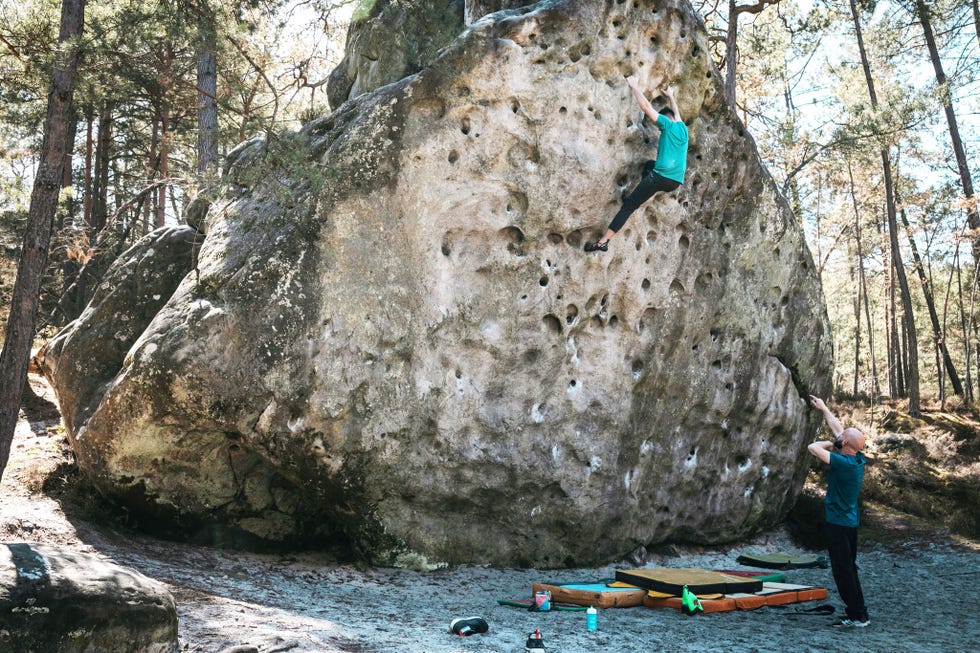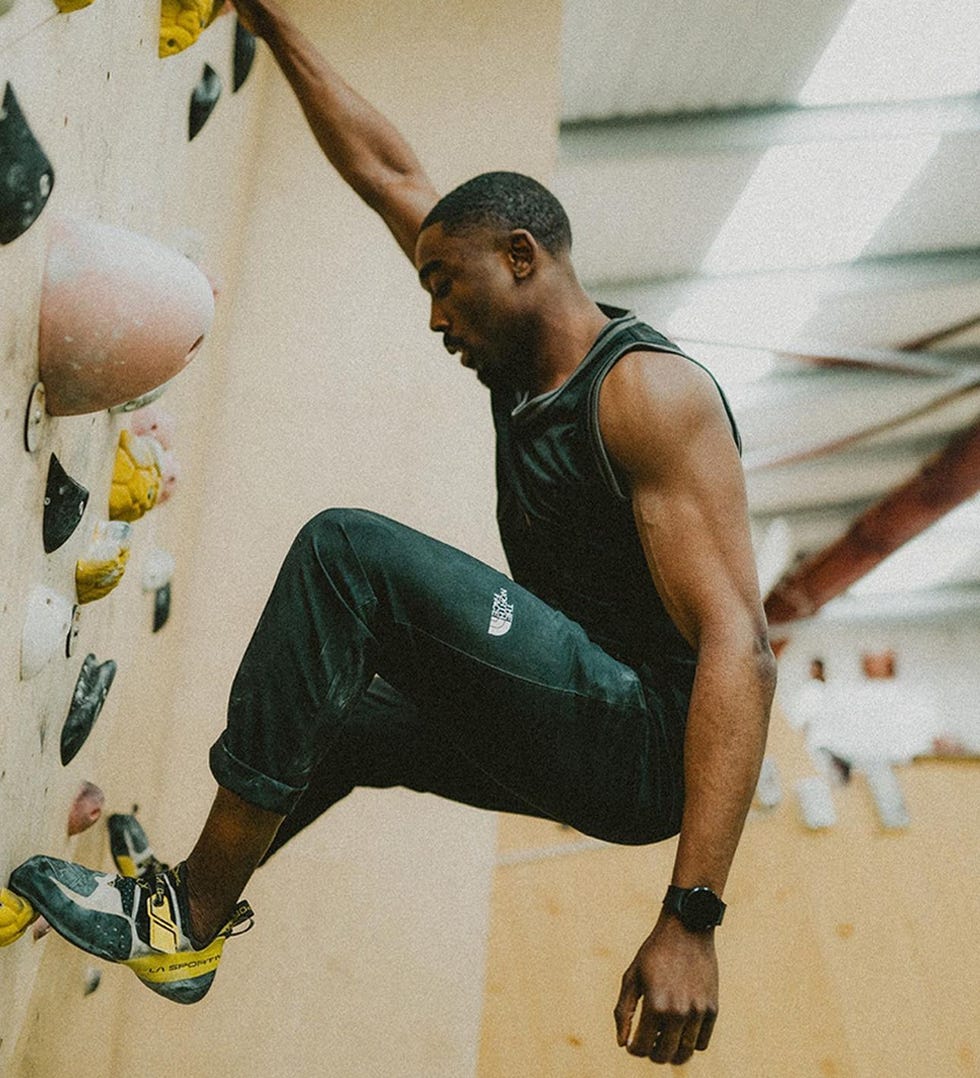Fitness
Bouldering: What Is The Latest Fitness Craze, And Could It Help You To Build Strength and Muscle?

With climbing centres popping up around the country, bouldering – a form of climbing which involves scaling low walls without ropes or harnesses – is blowing up. Our writer (a bouldering enthusiast) investigates its growing popularity, and speaks to those in the know. From the benefits to your strength and fitness, to where to go, what to wear and how to train, this is everything you need to know.
It’s mid afternoon on a Bank Holiday Monday and I’m stuck halfway up a wall, wedged between two half-moon-shaped plastic lumps. If I can just get my knee up onto one I can push my weight down and stand, precariously, with a foot on each. The problem is, just getting this far has opened up my knee, while my right wrist and elbow are about to cave in from injuries sustained last time I was here. Teetering between success and falling backwards, I push my weight down and go for it. I’m having the time of my life.
Bouldering is having a moment. Harry Styles is a fan. Ditto, Lady Gaga. In London, some indoor climbing centres double up as social spaces, offering pizza and beer on Friday night. It started with two films, The Dawn Wall and Free Solo, both released in 2018. For the first time, they brought rock climbing into the mainstream, making stars of American climbers Alex Honnold and Tommy Caldwell as they attempted impossible, death-defying feats at Yosemite National Park in California.
We don’t quite have Yosemite-level slabs in the UK, but we do have indoor bouldering gyms – 270 of them in England alone. On any given evening, I can be found climbing alongside upwards of 200 others at my local gym, most of them better than me. Instead of risking it all on outdoor crags, here, on four metre walls with thick, padded mats below, climbers can hone their skills on colourful holds graded by difficulty. It’s a way for outdoor rock climbers like Caldwell to hone their skills, and a sport in its own right; your local gym likely has a whole calendar of competitions for you to check out.
Tempted to give it a go? Here’s what you need to know.
What is Bouldering?
Bouldering is about climbing short, often indoor routes. ‘It’s rock climbing, but instead of using the ropes and harnesses, it’s done over crash pads on shorter walls,’ explains Ollie Rooke of London Climbing Centres. ‘Routes – or “problems” – in bouldering are shorter than in indoor or outdoor roped climbing, so they’re designed to be a bit tougher, with more of a focus on technique, strength and dynamism.’
After getting into the sport in 2019, Rotimi Odukoya, founder of Clmbxr and a North Face ambassador, recently transferred his skills to a climb outside, along some deep water cliffs. It’s best to master the basics first. ‘Bouldering emphasises strength, technique, and problem-solving skills, making it both a physical and mental challenge,’ he says.
Is There a Difference Between Rock Climbing and Bouldering?
Bouldering is just a sub-category of rock climbing, along with rope climbing.
Shauna Coxsey MBE, represented Great Britain at the 2020 Olympics and has won a number of World Cup victories. While retired from competition, she’s still out there sending (completing) incredibly difficult climbs, working with Red Bull, Adidas Terrex and The Climbing Hangar.
An expert in bouldering indoors and out, Coxsey says that the lack of attachments between a climber and the wall make bouldering ‘a very natural style of climbing’ with problems solved by ‘good technique and creativity’ as much as raw strength.
What is Harder Bouldering or Climbing?
‘Bouldering is rock climbing stripped down to its raw essentials,’ says James Gomez, owner of my local gym Boulder Brighton, and a 28-year veteran of the sport. ‘The climbs are high enough to be exciting, but not so high that they’re hugely intimidating.’
So, like most sports, bouldering is as hard as you make it. But if you don’t have a head for heights, bouldering is definitely the climbing discipline for you.
What Does Bouldering Do for My Strength and Fitness?
Bouldering requires you to move on various planes: up and down, forward and back, under and over obstacles, and sometimes even launching yourself diagonally from the wall in an attempt to grasp a protruding handhold (known as a ‘dyno’). It’s as much about upper body strength as it is feet co-ordination and mental resilience. Sometimes the only thing holding you in place is a thin, millimeter-thick finger hold, or having your heel hooked around a lower hold.
‘Bouldering, like all climbing, is fantastic for finger and grip strength but it is an all around workout so it tones and conditions every part of your body,’ agrees Coxsey. Finger strength is perhaps most important – a pulled tendon can put you out of action for weeks, with some climbers practising finger pull-ups and holds in their local gym’s warm-up area before each session.
‘Bouldering offers a serious workout for your arms, grip strength, and back, but it’s easy to underestimate just how much of an all-body workout you’ll face,’ adds Rooke. ‘You’ll use virtually every muscle during a session, from the ends of your rubber-clad toes to your fingertips. As a bodyweight exercise, there’s a huge emphasis on power and your strength-to-weight ratio, like calisthenics.’
‘It’s a full body work out,’ adds Coxsey. ‘You can explore it in your own way: You can go with friends and spend hours there or hit the wall for a focused power hour.’
How your body develops depends on what type of climber you are. If you prefer starting low down on the ground and climbing overhangs with your back inches from the floor, your hip flexors, grip strength and upper back will be especially important. Climbing ‘slab’ (that is, straight up, often with precarious footholds) is a slightly different skill set, as Rooke explains: ‘On overhanging walls you’ll need a strong core to maintain tension and keep you on the wall, while on vertical walls you’ll need to use finesse and balance alongside your strength to get to the top.’
Can I Get Fit and Build Strength Just from Bouldering?
Absolutely. Illustrator Leo Kember, 37, is among the most accomplished climbers at my gym and he’s only been doing it for 18 months. At average height, he also proves that there’s no such thing as a height advantage in bouldering. For Kember, the entirety of his fitness journey revolves around bouldering:
‘Prior to climbing, I had a bad back for years and didn’t enjoy anything athletic,’ he says. ‘I started bouldering a few sessions a month, but it escalated to four or five times a week. There’s an enjoyable aspect of climbing that I can’t imagine I’d find in a gym. I found myself getting stronger and more toned purely from climbing but I’ve recently started focusing on accessory work, adding in pull-ups, with a focus on hang time. By doing sets of five every now and then I can easily do 50 pull-ups across an evening without really noticing. I’ve begun adding variations into my sets by doing L-sit pull-ups, or feet to bars to get a better range.’
As if being one of the best climbers I know wasn’t enough, Kember’s begun showing off, too. ‘I’ve started experimenting with weighted pull-ups; I’ve managed an additional 28kg for a single pull up which adds up to 148% of my body weight,’ he says. ‘In spite of my lax approach to a training plan and my foolish reticence to take rest days I’ve found myself to be climbing progressively better and getting noticeably stronger and healthier – the regular exercise and the social side have also had a significant impact on my mental health.’
Where Should I Go for Bouldering?
There are plenty of outdoor rock faces from Dorset to the Peak District and beyond. All you need is a good guidebook, and a portable safety matt. But, it’s definitely advisable – and arguably, more fun – to start indoors.
London Climbing Centres offers access to eight centres, including the capital’s largest bouldering gym, HarroWall. Odukoya is a particular fan of The Castle Climbing Centre in London and The Climbing Hangar in Liverpool.
For outdoor climbs, Gomez recommends checking out The BMC’s (British Mountaineering Council) Regional Access Database. When it comes to finding a good indoor gym, he suggests looking for a centre that regularly switches up its routes: ‘That way if you end up climbing frequently, there will always be something new to try which can keep things fun and fresh,’ he says.
What Should I Wear for Bouldering?
Bouldering is perhaps the one sport where you can keep it simple when it comes to gear. ‘Wear comfortable sports gear that you won’t mind getting a little chalky. Climbing shoes and chalk can be rented when you visit. That’s it!’ says Rooke.
Odukoya favours comfortable, flexible clothing that offers a full range of motion. ‘Additionally, consider investing in chalk and a chalk bag,’ he suggests. Chalk can help with sweaty palms by offering an extra level of grip. You’ll even see climbers brushing holds to improve grip, but turning up for your first session with your own brush is a bit like playing a five-a-side match in shin pads – there’s really no need at that level.
Shoes will be your main outlay, but even then you can get a decent pair for fifty quid if you’re tired of renting. ‘Avoid buying shoes that are eye-wateringly tight – climbing shoes should be snug, to stop your foot moving around too much, but don’t need to be painful,’ advises Gomez. ‘Try shoes made by different manufacturers, just because your friend or favourite athlete swears by one shoe, it might not be the best one for you.’
How Should I Train for Bouldering?
‘I am going to shamelessly plug my husband’s book Beastmaking as a reference,’ says Coxsey. ‘It has everything you need to improve your climbing in an easily digestible way.’
It also helps to, well, get down to the wall and climb. ‘If you can manage two or three sessions a week, you will definitely notice lots of improvement,’ says Gomez, noting that the trick is to climb regularly without getting injured. ‘It’s easy to get over-excited and climb for too long or not give yourself enough rest time between heavy sessions,’ he says. ‘Warm up, listen to your body and make sure you don’t push yourself too hard when you’re starting out.’
Gomez also recommends pull-ups to replicate common climbing moves, as well as push-ups and core exercises to build a solid trunk and upper back. You should give your fingers extra care. ‘Finger boards and campus rungs are very intensive on the tendons and ligaments and are not recommended (or needed) until you’ve been climbing for at least a year or two,’ Gomez says. Instead, a lot of gyms sell rubber finger extenders or grip-strengthening tools for you to work with at home.
‘Finally, general fitness is important as it will help you with your endurance, both for climbing longer and for improving recovery times,’ says Gomez. ‘Bouldering is generally much more anaerobic than aerobic, so doing some cardio between climbing sessions is a great idea. Or combine the two and cycle to your climbing wall.’
Top Tips for the Best Bouldering Experience
There’s plenty to discover as you progress through your bouldering journey, from what the hell a ‘sloper’ is to just how much weight a coin-sized foothold can take. Coxsey’s final advice is to, ‘be respectful of other climbers around you. Be aware of where they are climbing and where they may fall.’ She also advocates for a social approach: ‘Don’t be afraid to chat with fellow climbers to solve any boulder problems you are working on; two heads are always better than one.’
Gomez urges all climbers not to ‘beta spray’: ‘When you see someone trying a climb or a move that you know the secret to, the urge to tell them what the solution is can be overwhelming. But don’t do it! Many climbers love the process of figuring out a climb, and taking this away from people can feel annoying.’
Beginner’s Checklist For Bouldering
From Clmbxr founder Rotimi Odukoya













